学术英语abstract写作
- 格式:ppt
- 大小:1.17 MB
- 文档页数:25
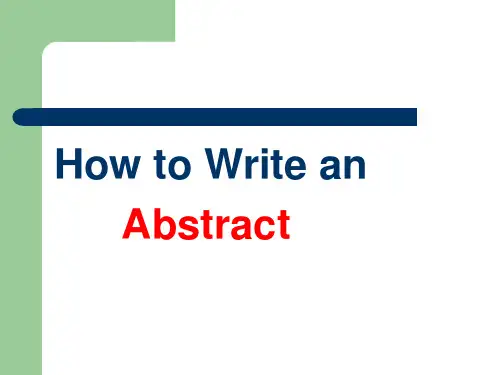
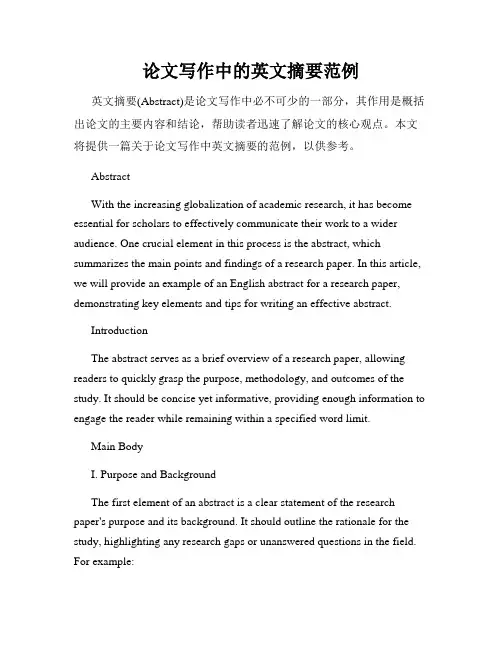
论文写作中的英文摘要范例英文摘要(Abstract)是论文写作中必不可少的一部分,其作用是概括出论文的主要内容和结论,帮助读者迅速了解论文的核心观点。
本文将提供一篇关于论文写作中英文摘要的范例,以供参考。
AbstractWith the increasing globalization of academic research, it has become essential for scholars to effectively communicate their work to a wider audience. One crucial element in this process is the abstract, which summarizes the main points and findings of a research paper. In this article, we will provide an example of an English abstract for a research paper, demonstrating key elements and tips for writing an effective abstract.IntroductionThe abstract serves as a brief overview of a research paper, allowing readers to quickly grasp the purpose, methodology, and outcomes of the study. It should be concise yet informative, providing enough information to engage the reader while remaining within a specified word limit.Main BodyI. Purpose and BackgroundThe first element of an abstract is a clear statement of the research paper's purpose and its background. It should outline the rationale for the study, highlighting any research gaps or unanswered questions in the field. For example:This research aims to investigate the effects of climate change on coastal ecosystems, with a focus on marine biodiversity and coral reef health. Given the increasing threats to these ecosystems, understanding the potential impacts of climate change is crucial for effective conservation strategies.II. MethodologyThe abstract should briefly describe the methodology employed in the research. This can include the study design, data collection methods, and analytical approaches. However, detailed technical information should be avoided. For example:A combination of field surveys, laboratory experiments, and statistical analyses were conducted to assess the long-term effects of temperature increase and ocean acidification on coral reefs. Data on species diversity, abundance, and health were collected from various reefs in the Caribbean region.III. ResultsThe abstract should highlight the key findings of the research. It should summarize the outcomes and conclusions derived from the data analysis. However, specific data or numerical results should be avoided, focusing instead on general trends and significant discoveries. For example:Our study revealed a significant decline in coral species diversity and overall health in response to increased water temperatures and ocean acidification. Furthermore, we found a decrease in the abundance of commercially important fish species, indicating potential impacts on local communities dependent on coral reef resources.IV. Implications and ConclusionThe abstract should conclude with a discussion of the broader implications of the research and its significance. It should provide a concise statement summarizing the main contributions of the study to the field and any recommendations for future research or policy implications. For example:These findings highlight the urgent need for immediate actions to mitigate the effects of climate change on coastal ecosystems. Implementing measures to reduce greenhouse gas emissions and establishing marine protected areas can help safeguard marine biodiversity and protect the livelihoods of communities dependent on coral reef resources.ConclusionIn conclusion, writing an effective English abstract is crucial for communicating the key points and contributions of a research paper. By providing a clear purpose, concise methodology, major findings, and broader implications, the abstract serves as a concise summary of the research work, enticing readers to delve deeper into the full paper. By following the guidelines and structure provided in this example abstract, researchers can enhance their chances of effectively conveying their research to a global audience.。
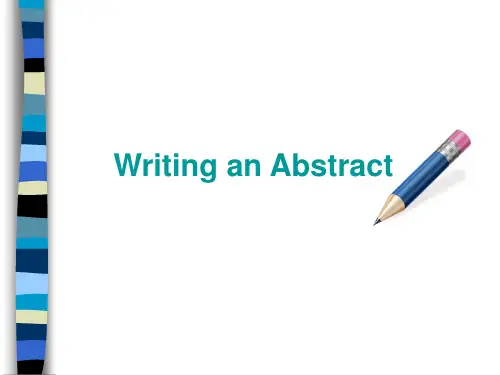
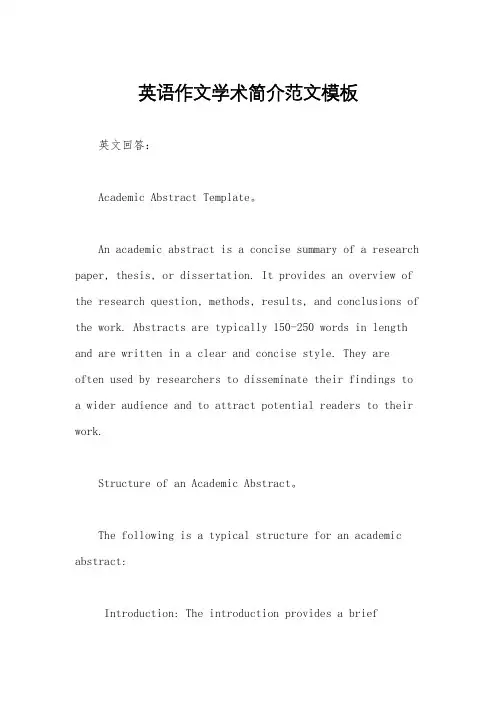
英语作文学术简介范文模板英文回答:Academic Abstract Template。
An academic abstract is a concise summary of a research paper, thesis, or dissertation. It provides an overview of the research question, methods, results, and conclusions of the work. Abstracts are typically 150-250 words in length and are written in a clear and concise style. They are often used by researchers to disseminate their findings to a wider audience and to attract potential readers to their work.Structure of an Academic Abstract。
The following is a typical structure for an academic abstract:Introduction: The introduction provides a briefoverview of the research topic and the research question being addressed.Methods: The methods section describes the research design, data collection methods, and data analysis techniques used in the study.Results: The results section presents the key findings of the study, including any statistical tests or other analyses that were conducted.Conclusions: The conclusions section summarizes the main findings of the study and discusses their implications.Tips for Writing an Effective Abstract。
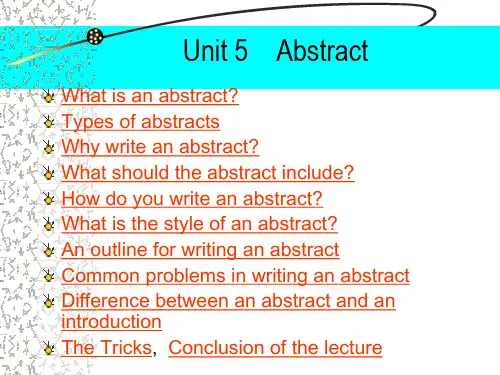
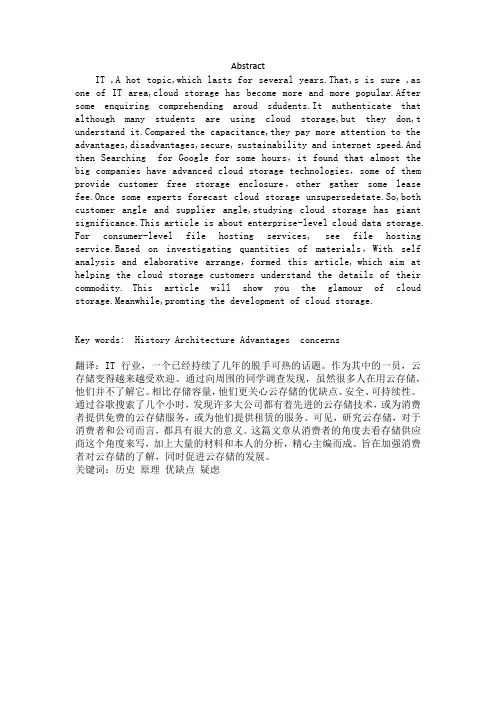
AbstractIT ,A hot topic,which lasts for several years.That,s is sure ,as one of IT area,cloud storage has become more and more popular.After some enquiring comprehending aroudsdudents.It authenticate that although many students are using cloud storage,but they don,t understand pared the capacitance,they pay more attention to the advantages,disadvantages,secure,sustainability and internet speed.Andthen Searching for Google for some hours,it found that almost the big companies have advanced cloud storage technologies,some of them provide customer free storage enclosure,other gather some lease fee.Once some experts forecast cloud storage unsupersedetate.So,both customer angle and supplier angle,studying cloud storage has giant significance.This article is about enterprise-level cloud data storage. For consumer-level file hosting services, see file hosting service.Based on investigating quantities of materials,With self analysis and elaborative arrange,formed this article,which aim at helping the cloud storage customers understandthe details of their commodity.This article will show you the glamour of cloud storage.Meanwhile,promting the development of cloud storage.Key words: History Architecture Advantages concerns翻译:IT 行业,一个已经持续了几年的脱手可热的话题。
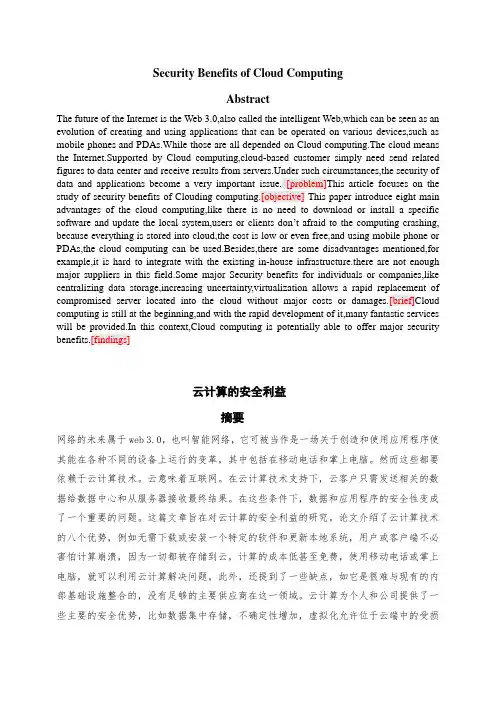
Security Benefits of Cloud ComputingAbstractThe future of the Internet is the Web 3.0,also called the intelligent Web,which can be seen as an evolution of creating and using applications that can be operated on various devices,such as mobile phones and PDAs.While those are all depended on Cloud computing.The cloud means the Internet.Supported by Cloud computing,cloud-based customer simply need send related figures to data center and receive results from servers.Under such circumstances,the security of data and applications become a very important issue.[problem]This article focuses on the study of security benefits of Clouding computing.[objective] This paper introduce eight main advantages of the cloud computing,like there is no need to download or install a specific software and update the local system,users or clients don’t afraid to the computing crashing, because everything is stored into cloud,the cost is low or even free,and using mobile phone or PDAs,the cloud computing can be used.Besides,there are some disadvantages mentioned,for example,it is hard to integrate with the existing in-house infrastructure.there are not enough major suppliers in this field.Some major Security benefits for individuals or companies,like centralizing data storage,increasing uncertainty,virtualization allows a rapid replacement of compromised server located into the cloud without major costs or damages.[brief]Cloud computing is still at the beginning,and with the rapid development of it,many fantastic services will be provided.In this context,Cloud computing is potentially able to offer major security benefits.[findings]云计算的安全利益摘要网络的未来属于web 3.0,也叫智能网络,它可被当作是一场关于创造和使用应用程序使其能在各种不同的设备上运行的变革,其中包括在移动电话和掌上电脑。
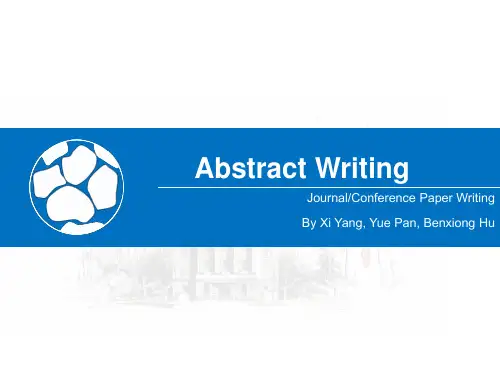
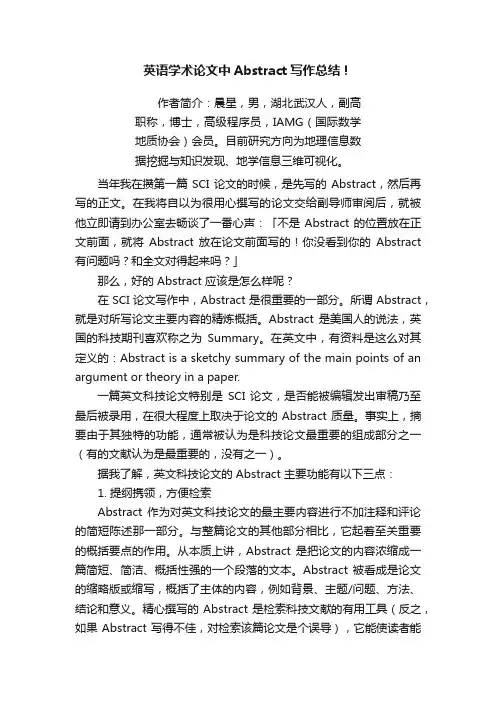
英语学术论文中Abstract写作总结!作者简介:晨星,男,湖北武汉人,副高职称,博士,高级程序员,IAMG(国际数学地质协会)会员。
目前研究方向为地理信息数据挖掘与知识发现、地学信息三维可视化。
当年我在攒第一篇 SCI 论文的时候,是先写的 Abstract,然后再写的正文。
在我将自以为很用心撰写的论文交给副导师审阅后,就被他立即请到办公室去畅谈了一番心声:「不是 Abstract 的位置放在正文前面,就将Abstract 放在论文前面写的!你没看到你的Abstract 有问题吗?和全文对得起来吗?」那么,好的 Abstract 应该是怎么样呢?在 SCI 论文写作中,Abstract 是很重要的一部分。
所谓 Abstract,就是对所写论文主要内容的精炼概括。
Abstract 是美国人的说法,英国的科技期刊喜欢称之为Summary。
在英文中,有资料是这么对其定义的:Abstract is a sketchy summary of the main points of an argument or theory in a paper.一篇英文科技论文特别是SCI 论文,是否能被编辑发出审稿乃至最后被录用,在很大程度上取决于论文的 Abstract 质量。
事实上,摘要由于其独特的功能,通常被认为是科技论文最重要的组成部分之一(有的文献认为是最重要的,没有之一)。
据我了解,英文科技论文的 Abstract 主要功能有以下三点:1. 提纲携领,方便检索Abstract 作为对英文科技论文的最主要内容进行不加注释和评论的简短陈述那一部分。
与整篇论文的其他部分相比,它起着至关重要的概括要点的作用。
从本质上讲,Abstract 是把论文的内容浓缩成一篇简短、简洁、概括性强的一个段落的文本。
Abstract 被看成是论文的缩略版或缩写,概括了主体的内容,例如背景、主题/问题、方法、结论和意义。
精心撰写的Abstract是检索科技文献的有用工具(反之,如果 Abstract 写得不佳,对检索该篇论文是个误导),它能使读者能够更快、更方便地识别论文的基本内容,确定论文与其个人兴趣相关性,并最终决定是否需要继续阅读整篇论文。
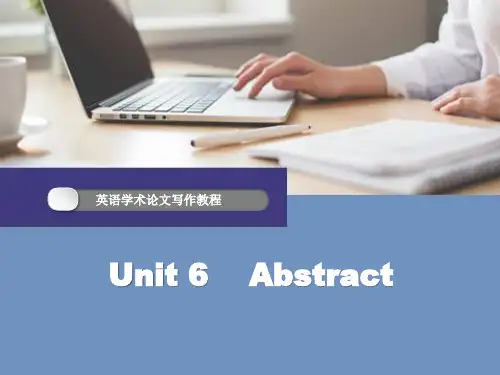
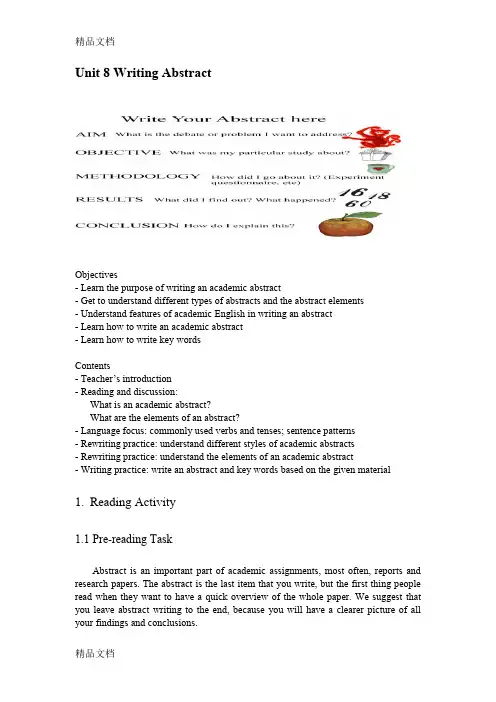
Unit 8 Writing AbstractObjectives- Learn the purpose of writing an academic abstract- Get to understand different types of abstracts and the abstract elements- Understand features of academic English in writing an abstract- Learn how to write an academic abstract- Learn how to write key wordsContents- Teacher’s introduction- Reading and discussion:What is an academic abstract?What are the elements of an abstract?- Language focus: commonly used verbs and tenses; sentence patterns- Rewriting practice: understand different styles of academic abstracts- Rewriting practice: understand the elements of an academic abstract- Writing practice: write an abstract and key words based on the given material1.Reading Activity1.1 Pre-reading TaskAbstract is an important part of academic assignments, most often, reports and research papers. The abstract is the last item that you write, but the first thing people read when they want to have a quick overview of the whole paper. We suggest that you leave abstract writing to the end, because you will have a clearer picture of all your findings and conclusions.Before you learn the detailed steps to write an abstract, please discuss the following questions:What is the purpose of writing an abstract?What are the basic elements for an academic abstract?What language problems may you have in abstract writing? (For example: the wording problem, the tense problem and the voice problem, etc.)1.2Reading PassageSample Abstract 1This dissertation examines the impacts of social movements through a multi-layered study of the Mississippi Civil Rights Movement from its peak in the early 1960s through the early 1980s. By examining this historically important case, the writer clarifies the process by which movements transform social structures and the constraints when they try to do so. The time period studied includes the expansion of voting rights and gains in black political power, the desegregation of public schools and the emergence of white-flight academies, and the rise and fall of federal anti-poverty programs. Two major research strategies were used: (1) a quantitative analysis of county-level data and (2) three case studies. Data have been collected from archives, interviews, newspapers, and published reports. This dissertation challenges the argument that movements are inconsequential. Some view federal agencies, courts, political parties, or economic elites as the agents driving institutional change, but typically these groups acted in response to the leverage brought to bear by the civil rights movement. The Mississippi movement attempted to forge independent structures for sustaining challenges to local inequities and injustices. By propelling change in an array of local institutions, movement infrastructures had an enduring legacy in Mississippi.(Kenneth Tait Andrews, “‘Freedom is a constant struggle’: The dynamics and consequences of the Mississippi Civil Rights Movement, 1960-1984″ Ph.D. State University of New York at Stony Brook, 1997 DAI-A 59/02, p. 620, Aug 1998)1.3 Reading Comprehension1.3.1 What does the abstract talk about?1.3.2Decide how many elements this sample includes and how they function.2Language Focus2.1 Commonly used verbs and tenses in abstractsRead the following sample abstract and pay attention to the verbs used in it. Sample abstract 2Cybercrime –crime on the Internet –is of growing concern in the business community. Despite UK Government initiatives (such as BS7799) and growing sales in software solutions (e.g. anti-virus software), cyber attacks are on the increase. This dissertation focuses on ways to assess the effectiveness of current preventative measures to cybercrime and to understand why organizations continue to be vulnerable to cybercrime. This dissertation met these twin research aims through an extensive study of relevant literature and the implementation of practical research. The latter was carried out through a Case Study with Company XXX using semi-structured interviews with key I.T. security personnel. This research produced a number of key findings: recent surveys confirm a significant increase in the incidences of cybercrime and their impact on the business community but also the types of cybercrime (viruses, hacking, spam, identity theft, fraud, privacy issues, web vandalism, etc.); organizations lacked the security expertise to deal with cybercrime and so depended too much on readily available technical ways to combat cybercrime (and failing); organizations were not aware of Government recommendations on how to address Internet-based security issues; and Governments and law enforcement agencies tended to localize cybercrime, allocating scant resources to contributing to a global solution. The main conclusions drawn from this research were that current approaches to fighting cybercrime are deficient because they fail to embrace a holistic approach, instead opting for a narrow local software-based focus, and that a lack of communication between major stakeholders at local, national and international level has hindered security development. This research argues for a multi-pronged model to reduce incidences of cybercrime. It takes into account Risk-Assessment models, local management of company policies, implementation issues (including proper resourcing and review policies), the need for global support infrastructures, and a means of fostering communication networks.(/Dissertation_Abstract.htm)2.2 More verbs and sentences patterns2.2 Verb tenses in abstractsRead the abstract above again and check the tenses in the abstract.3Writing Practice3.1 Abstract writing practice3.1.1 Why do we care about the problem and the results? If the problem is not obviously "interesting", it might be better to put motivation first; but if your work is incremental progress on a problem that is widely recognized as important, then it is probably better to put the problem statement first to indicate which piece of the larger problem you are breaking off to work on. This section should include the importance of your work, the difficulty of the area, and the impact it might have if successful. Read the following paragraph and write down the Motivation in the blank.A review of groundwater remediation in use today shows that new techniques are required to solve the problems of pump and treat, containment and in-situ treatment. One such technique is the method that involves the use of permeable treatment walls. These methods use a reactive medium such as iron to remediate contaminated groundwater.3.1.2 What problem are you trying to solve? What is the scope of your work (a generalized approach, or for a specific situation)? Be careful not to use too much jargon. In some cases it is appropriate to put the problem statement before the motivation, but usually this only works if most readers already understand why the problem is important. Read the following paragraph and write the problem (aim) in the blank.Several methods of implementing this remediation strategy have been described. These methods include injection and trenching. The use of a funnel and gate system via a trench has been examined in detail using a groundwater modeling option of the FLAC program.3.1.3 How did you go about solving or making progress on the problem? Did you use simulation, analytic models, prototype construction, or analysis of field data for an actual product? What was the extent of your work (did you look at one application program or a hundred programs in twenty different programming languages?) What important variables did you control, ignore, or measure? Read the following paragraph and write the approach in the blank.The use of a funnel and gate system via a trench has been examined in detail using a groundwater modeling option of the FLAC program. The modeling involved an analysis of the effect of changing the lengths of the walls and gate, varying the permeability, and varying the number of gates.3.1.4 What is the answer? Specifically, most good computer architecture papers conclude that something is so many percent faster, cheaper, smaller, or otherwise better than something else. Put the result there, in numbers. Avoid vague, hand-waving results such as "very", "small", or "significant." If you must be vague, you are only given license to do so when you can talk about orders-of-magnitude improvement. There is a tension here in that you should not provide numbers that can be easily misinterpreted, but on the other hand, you do not have room for all the caveats. Read the following paragraph and write the result in the blank.The results showed that increasing the wall length, gate length and permeability increases the size of the plume captured. An important factor in designing the walls is the residence time of the water in the gate or the contact time of the contaminant with the reactive media.3.1.5 What are the implications of your answer? Is it going to change the world (unlikely), be a significant "win", be a nice hack, or simply serve as a road sign indicating that this path is a waste of time (all of the previous results are useful). Are your results general, potentially generalizable, or specific to a particular case? Read the following and write the conclusion in the blank:A sensitivity analysis has been conducted that shows that increasing the size of the capture zone decreases the residence time which will limit the design. The results of the modeling and sensitivity analysis are presented so that they can be used as an aid to the design of permeable treatment walls.3.2 The following is a structured abstract from a report examining the network legitimacy in China telecommunication market (Low, Johnston, and Wang 97). Read it and transfer it into an informative abstract.Abstract structurePurpose – The purpose of this paper is to establish the importance and approaches in securing an organization’s legitimacy from the network community of customers, suppliers and manufacturers, including private investors and state-owned institutions when marketing their products.Design/methodology/approach –The paper presents an inductive interpretative approach complemented by action-based research founded on inquiry and testing.Findings –The paper finds that the key to legitimacy success involves using legitimacy orientations to demonstrate commitment to the interests of constituents, acquiring legitimacy from them, but concurrently considering the central government’s influence on a firm’s legitimacy performance.Research limitations/implications –The multiple interactions proposed in this paper remain untested and might have to be modified pending further empirical testing and analysis.Practical implications –In China’s telecommunication market, a company’s legitimacy emanates first and foremost from the development and commercialization of innovative and creative technological solutions. This requires good, creative management of technological resource and activity links, connecting the company’s technology to network constituents which include local manufacturers, carriers, software developers, investors.Originality/value – This is the first published paper that examines the proposed interactions among legitimacy orientations, alignments, and performances from a “market-as-network” perspective in a dynamic, transitional Chinese telecommunication market.3.3Writing keywordsKeywords often stand alone after the Abstract. In choosing the key words, a wide choice of keywords increases the probability that a paper will be retrieved and read, thereby potentially improving citation counts and journal impacts. To ensure that your paper can be found and cited by as many readers as possible, as suggested by James Hartley, it might be worth considering selecting keywords from a series of categories such as Discipline (e.g. economic, chemistry, biomedical), Methods (e.g. experiment, case study, questionnaire, grounded theory), Data source (e.g. primary, secondary, tertiary students, senior citizens), Location (e.g. country, city, town, institution), Topic (e.g. air pollution, super-virus, earthquake). Such a selection of keywords allows the search engine, such as Google Advanced Scholar, to list your paper in the results no matter which of the above keywords the reader types in.The researchers sometimes have to trade-off between the keywords, particularly when they write for the journals that bound the number of keywords in the limit of 3~5. In this situation, choose the keywords from recent or often-cited titles close to your contribution. If you pick your keywords in this way, the searches that retrieve these articles will also retrieve yours. Consequently, the chances of your paper being read will increase. Read the above sample abstracts and write down the key words:4. Writing project4.1 Get prepared for writing an abstractBefore you write the Abstract section of your research paper, you need to make everything ready for your writing. The following steps may be helpful for your preparation.1) Identify the major objectives and conclusions.2) Identify phrases with keywords in the methods section.3) Identify the major results from the discussion or results section.4) Assemble the above information into a single paragraph.5) State your hypothesis or method used in the first sentence.6) Omit background information, literature review, and detailed description ofmethods.7) Remove extra words and phrases.8) Revise the paragraph so that the abstract conveys only the essential information.9) Check to see if it meets the guidelines of the targeted journal.10) Give the abstract to a colleague (preferably one who is not familiar with yourwork) and ask him/her whether it makes sense.Work in groups and discuss what other preparations you can make for writing an abstract section of your research paper.4.2 Outline an abstractWhen we outline an abstract, there are usually five major aliments to follow. The following sample paper is finished without the abstract and key words. Read the paper, find the statements concerned and fill in the blank after it.Sample paperGLOBAL MEGACITIES AND LOW CARBON: FROM CONCEPT PLANNING TO INTEGRATED MODELLINGPhil Jones, Simon Lannon, Robbert van Nouhuys, Hendrik RosenthalMega citiesIn 1950, 30% of the world’s population lived in cities. In 2000, it was 47%. By 2010 more than half of the world’s population will be living in cities. The total may even reach 60% by 2030 and possibly 85% by the middle of this century. Such rapidly increasing urbanization, particularly in developing countries, creates many opportunities and challenges.We are living in a globalized and changing world whereby increasingly we require wise use of human and natural resources. At the same time, we need to reduce the risk urbanization poses and enhance the quality of life for all those who live in, or are impacted by Megacities. Megacities are more than just large cities with populations of 10 million inhabitants or more. They are critical to national economies. Their scalecreates new dynamics, new complexity and new simultaneity of events and processes –physical, social and economic. They host highly efficient economic activities utilizing intense and complex interactions between different demographic, social, political, economic and ecological processes.Nations undergoing economic progress often generate rapid urbanization linked with considerable opportunities, as well as strong pressures for change accompanied by environmental degradation. In current times in the developing world, Megacities grow faster than ever before and much faster than their infrastructure can support. Traditionally this results in uncontrolled urban sprawl, high traffic volumes and congested transport systems, high concentrations of industrial production, ecological overload, unregulated and disparate land and property markets, insufficient housing development, excessive waste generation, loss of productivity, general economic constipation, degradation and decline.Over the past decades traditional Megacities have been suffering from inadequate representative governance, inhibiting spatial planning, building control, delivery of services (such as water supply, sewage disposal and energy distribution), and the establishment of general order (including security and disaster prevention). Existing administrations and their organizational structures may have been outgrown by the rapidly expanding city and may simply be unable to cope with the huge scale of their new responsibilities. On the other hand, megacities contain a rich mix of coexisting people and support systems when properly planned and managed. Groups with their own distinctive ethnic, community, cultural roots, lifestyles and social surroundings have opportunity to thrive and develop. Differences in economic development, social polarization, quality of infrastructure and governance are recognized and taken into account. The scale and dynamism of Megacities, coupled with complex interacting processes and the sheer concentration of human capital make them incubators of huge growth and innovation. Megacities are the focal points of globalization as well as the driving forces for development; they harbor a wide spectrum of human skill and potential, creativity, social interaction and cultural diversity.For Hanoi to develop within a rapid urbanization scenario it must look far ahead –not 20 years, not 50 years but 100 years –into the 22nd Century. The use of conventional planning and economic development guidelines have proven to be outdated, resulting in the risk of harboring pronounced poverty, social inequality, and aggravating rapid environmental degradation. Population density, if not managed, increases vulnerability to natural and man-made hazards. Thus, Megacities are both victims and producers of risk, if unmanaged and exposed to the global environmental, socio-economic and political changes to which they contribute.Megacities will be essential and efficient drivers of a nation’s gross domestic product, processes and activities. Megacities will be ideal places to drive activities and innovation to solve social, environmental, medical, socio-economic and political issues. For these reasons, Megacities are necessary and have potential to substantially contribute towards global justice and peace – and thereby prosperity.Low Carbon and Energy ModelingAspects of sustainable master planning that impact carbon and energy implications need to be understood to help inform concepts at the earliest stage of the design process. For example, the full benefits of reducing operating energy demand of buildings can only be realized if the energy supply can respond to the reduced demand, which includes the additional benefits of reducing the energy supply infrastructure, which in turn reduces its embodied energy. Likewise, if a low (or zero) carbon energy supply is to be used, for example, renewable energy, this is easier to achieve if first the energy demand is reduced. Also, as the operating energy performance of buildings is improved the carbon dioxide emissions associated with the operation of the building, for heating, cooling, lighting, etc., becomes of the same order as the embodied energy used in construction and fit-out of the building and its infra-structure. So a balanced approach across energy demand and supply infrastructure, operating energy and embodied energy, is needed to achieve optimum performance.This paper describes how the aspects of low carbon planning and design (i.e. operating energy use, embodied energy associated with buildings, energy supply infrastructures, and other infrastructures such as transport, waste, water, sewage, etc.) can be assessed using urban scale modeling, namely EEP-Urban, at a whole city and building plot level. In particular, it explores how the reduction in energy supply infrastructure together with reduced energy demand can lead to reductions in carbon dioxide emissions associated with both operating and embodied energy. The concept of the Megacity in the context of Hanoi in 2110 is used to illustrate the model.The Concept of Metabolic Super ClustersHanoi in 2110 will feature super tall skyscrapers, elevated connectors and railways, nodal communication networks, as well as electrical and energy corridors. Vertical neighborhoods, where people live, shop, relax and work, are built on and above this surface. Built structures are not just individual towers standing independent from another but instead are interlinked and inter-dependent to form an urban spatial organization that allows for vertical connectivity.The urban model proposes 1 million people on a 1 square kilometer floor plate, hence called a Super Cluster. Under current suburban density standards a similar population would require in the order of 100 square kilometers. Thus, this vision for Hanoi in 2110 saves 99% of land for other uses, most notably conservation of ecological functions and provides food, leisure, material and energy support systems for the city thereby localizing the ecological footprint of the city.Another distinct aspect of Hanoi in 2110 is that it does not have static building functions. Instead, land use layers, building envelopes and orientations change over time – hourly, daily, weekly, monthly, yearly – to optimize performance efficiencies, therefore becoming a Metabolic Super Cluster. It is envisaged that Hanoi by the end of this century will consist of 30 metabolic super clusters in addition to its traditional urban city centre.Concentrated compact development will enhance the quality of life for urban dwellers because all infrastructures, environmentally damaging and other undesirablesurface activities are located underground or integrated into the vertical structure, thereby significantly improving the quality of living space at the ground, open-air level. Underground space may also provide a safer environment for some public and commercial activities as well as providing shelter from inclement weather conditions. This may prove to be essential for infrastructure in particular, given the predicted impacts associated with climate change. Elevated multi-level connectors between building clusters are converted into common corridors with public amenities, farms and open space.Quality of life depends on individual perceptions, attitudes, aspirations and value systems. These differ with age, ethnicity, culture and religion, as well as lifestyles, education and cultural background. An individual’s priorities and attitudes to life depend heavily upon socio-economic background and cultural environment. Historic places, cultural sites or public spaces may give Megacities a certain unique identity, heritage, and authenticity. As a result, such spatial capital contributes to social cohesion and makes people feel at home.Nevertheless, the general opinion may be that the quality of life for many residents in Megacities would be low – for rich and poor alike. Air, water and soil pollution, water and energy supply shortages, traffic congestion, environmental health problems, limited green spaces, poverty and malnutrition, social security and public safety problems place many burdens and restrictions on people.The Megacity of the future has adapted to greater diversity in socio-cultural circumstances by including and enhancing the often widespread and dynamic informal activities that enrich such communities. Further development of new visions and innovative management tools are now urgently needed in order to enhance quality of life and create cohesive communities.Urban governance and management is one of the key success factors of any global Megacity. As society and aspirations evolve over time, the city has to be designed to adapt to change. Utopian cities built around fixed ideologies have never worked. Megacities need to be versatile in order to adapt.The main challenges for a Megacity in terms of urban governance are: dealing with the speed of change with intelligent urban infrastructure systems; eradicating social exclusion; and introducing proper forms of urban governance.Way ForwardWhether or not 1 million people are appropriate for a 1 km2 super cluster remains to be seen. The optimum density for sustainability, land use and quality of life may be less and will vary with global location. The above approach is essential to inform the design of high rise high density Megacities if they are to realize their full potential for providing sustainable healthy zero carbon cities of the future that can co-exist in a sustainable way with their neighboring rural areas.4.3 According to the above table, draft an abstract and keywords for the sample paper. Abstract:Key words:5.Final Checklistbackground, purpose, findings, conclusions, recommendations and follow strictly the chronology of the report/papers.∙Avoid excessive use of jargon, and exaggerative language∙Keep within the specified word limit. Most institutions will have their own "house rules" as to the length of the abstract. The abstract should stand alone and be able to be understood without reference to citations,∙Ensure the abstract contains all your key words (for the searchable databases). ∙Add no new information but simply summarize the report/papers. Be intelligible to a wide audience。
英文abstract范文In the realm of academic writing, an abstract is a concise summary of a research paper or study, presenting the key points and findings without delving into the details. It serves as a window into the content, enticing readers to explore further.The abstract should begin with a brief introduction of the research topic, highlighting its significance and relevance in the field. It is crucial to establish the context and purpose of the study to pique the interest of the reader.Next, the methodology section of the abstract should succinctly describe the approach taken in the research. Whether it's a qualitative study, quantitative analysis, or a mix of both, the abstract should outline the techniques used to gather and analyze data.Following the methodology, the abstract must present the main findings of the research. These should be presented in a clear and concise manner, avoiding any jargon that could confuse the reader. The goal is to convey the essence of the results without overwhelming the reader with data.The conclusion of the abstract should succinctly summarize the implications of the findings. It should highlight how the research contributes to the existing bodyof knowledge and what the potential impact might be on the field.Lastly, the abstract may include a few keywords that encapsulate the core themes of the research. These keywords help in the indexing of the paper and facilitate easy retrieval by interested readers.Remember, the abstract is often the first and sometimes the only part of a paper that readers will see. It is, therefore, the key to capturing their attention and convincing them of the value of your research.。